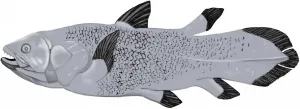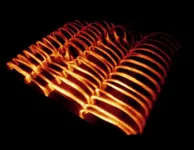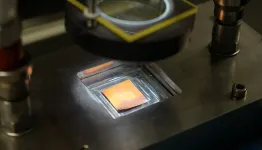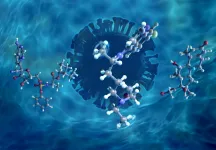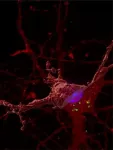(Press-News.org) Researchers at Lund University in Sweden have discovered the individual traits of fungi, and how their hyphae - that is, the fungal threads that grow in soil - behave very differently as they navigate through the earth's microscopic labyrinths.
The study was performed in a lab environment, and the underground system constructed synthetically from silicone. Using a microscope, researchers were able to follow seven species and compare their behaviour. How do they react when the maze they grow in turns sharply and forces the hyphae to grow in the direction it came from? What happens when a large space opens up in front of them?
"Under a microscope, their behaviour becomes much more personal than you can ever imagine. They become individual characters", says Edith Hammer, one of the researchers behind the study.
The research team discovered that the fungi use different strategies when they grow and form their structures, the so-called mycelium. The different characteristics have led the researchers to give the various fungi nicknames such as "the soldier", the marathon runner" and "the snake".
The soldier gained its name because it grows with great force, and plows down obstacles in its path, yet it does not get very far. The marathon runner, on the other hand, sends out hypha that act like 'lone fighters', and grow quite far before giving up their search for food. However, this requires that they do not encounter tough obstacles, as this is their weak spot. Unlike the marathon runner, the snake specializes in weaving and growing around obstacles.
Examples of obstacles that the hyphae may encounter, and that can delay and confuse them, are zigzag patterns, sharp angles and rounded corners. The study shows that some species simply stop when they end up in a corner.
The research is unique because it is the first time that the behaviour of individual hyphae in multiple species has been studied in parallel and in detail. Previous studies have often focused on the mycelium as a whole, as they have not been able to distinguish the behaviour of individual hyphae.
So far, however, important pieces of the puzzle are missing on how microscopic soil structures affect the behaviour of fungi, in order for the research to have practical applications in agriculture.
INFORMATION:
Parasitic worms could hold the key to living longer and free of chronic disease, according to a review article published today in the open-access eLife journal.
The review looks at the growing evidence to suggest that losing our 'old friend' helminth parasites, which used to live relatively harmlessly in our bodies, can cause ageing-associated inflammation. It raises the possibility that carefully controlled, restorative helminth treatments could prevent ageing and protect against diseases such as heart disease and dementia.
"A decline in exposure to commensal microbes and gut helminths in developed countries ...
A greater exposure to air pollution at the very start of life was associated with a detrimental effect on people's cognitive skills up to 60 years later, the research found.
Researchers at the University of Edinburgh tested the general intelligence of more than 500 people aged approximately 70 years using a test they had all completed at the age of 11 years.
The participants then repeated the same test at the ages of 76 and 79 years.
A record of where each person had lived throughout their life was used to estimate the level of air pollution they had experienced in their early years.
The team used statistical models to analyse the relationship between a person's exposure to air pollution ...
To evaluate the chemical composition of food from a physiological point of view, it is important to know the functions of the receptors that interact with food ingredients. These include receptors for bitter compounds, which first evolved during evolution in bony fishes such as the coelacanth. What 400 million years of evolutionary history reveal about the function of both fish and human bitter receptors was recently published in the journal Genome Biology and Evolution by a team of researchers led by the Leibniz Institute for Food Systems Biology at the Technical University of Munich and the University of Cologne.
Evolutionarily, bitter receptors are a relatively recent invention of nature compared ...
A process that releases iron in response to stress may contribute to heart failure, and blocking this process could be a way of protecting the heart, suggests a study in mice published today in eLife.
People with heart failure often have an iron deficiency, leading some scientists to suspect that problems with iron processing in the body may play a role in this condition. The study explains one way that iron processing may contribute to heart failure and suggests potential treatment approaches to protect the heart.
"Iron is essential for many processes in the body including oxygen transport, but too much iron can lead to a build-up of unstable oxygen molecules that can kill cells," says ...
Trees are by far the tallest organisms on Earth. Height growth is made possible by a specialized vascular system that conducts water from the roots to the leaves with high efficiency, while simultaneously providing stability. The so-called xylem, also known as wood, is a network of hollow cells with extremely strong cell walls that reinforce the cells against the mechanical conflicts arising from growing tall. These walls wrap around the cells in filigree band and spiral patterns. So far, it is only partly known, how these patterns are created. Scientists from the Max Planck Institute for Molecular Plant Physiology in Golm/Potsdam and from ...
Carbon dioxide (CO2) is one of the major greenhouse gases causing global warming. If carbon dioxide could be converted into energy, it would be killing two birds with one stone in addressing the environmental issues. A joint research team led by City University of Hong Kong (CityU) has developed a new photocatalyst which can produce methane fuel (CH4) selectively and effectively from carbon dioxide using sunlight. According to their research, the quantity of methane produced was almost doubled in the first 8 hours of the reaction process.
The research was led by Dr Ng Yun-hau, Associate Professor in the ...
King Richard III's involvement in one of the most notorious and emotive mysteries in English history may be a step closer to being confirmed following a new study by Professor Tim Thornton of the University of Huddersfield.
Richard has long been held responsible of the murder of his nephews King Edward V and his brother, Richard, duke of York - dubbed 'the Princes in the Tower' - in a dispute about succession to the throne. The pair were held in the Tower of London, but disappeared from public view in 1483 with Richard taking the blame following his death two years later.
It has become of the most ...
In the United States only about 1.3 percent of all vehicles sold last year were battery powered. And about 90 percent of those sales were by one company -- Tesla. What has Tesla done right and where have other electric vehicle makers gone wrong?
Electric vehicles cannot succeed without developing a nationwide network of fast-charging networks in parallel with the cars. Current EV business models are doomed unless manufacturers that have bet their futures on them, like General Motors and VW, invest in or coordinate on a robust supercharger network. These are the observations in an in-depth study of the industry by management professors at the University of California, Davis, and Dartmouth College.
The researchers explain that big ...
As the scientific community continues researching the novel coronavirus, experts are developing new drugs and repurposing existing ones in hopes of identifying promising candidates for treating symptoms of COVID-19.
Scientists can analyze the molecular dynamics of drug molecules to better understand their interactions with target proteins in human cells and their potential for treating certain diseases. Many studies examine drug molecules in their dry, powder form, but less is known about how such molecules behave in a hydrated environment, which is characteristic of human cells.
Using neutron experiments and computer ...
University of Queensland researchers have discovered a new 'seeding' process in brain cells that could be a cause of dementia and Alzheimer's disease.
UQ's Queensland Brain Institute dementia researcher Professor Jürgen Götz said the study revealed that tangled neurons, a hallmark sign of dementia, form in part by a cellular process that has gone astray and allows a toxic protein, tau, to leak into healthy brain cells.
"These leaks create a damaging seeding process that causes tau tangles and ultimately lead to memory loss and other impairments," Professor Götz said.
Professor Götz said until now researchers did not understand how tau seeds were able to escape after ...
